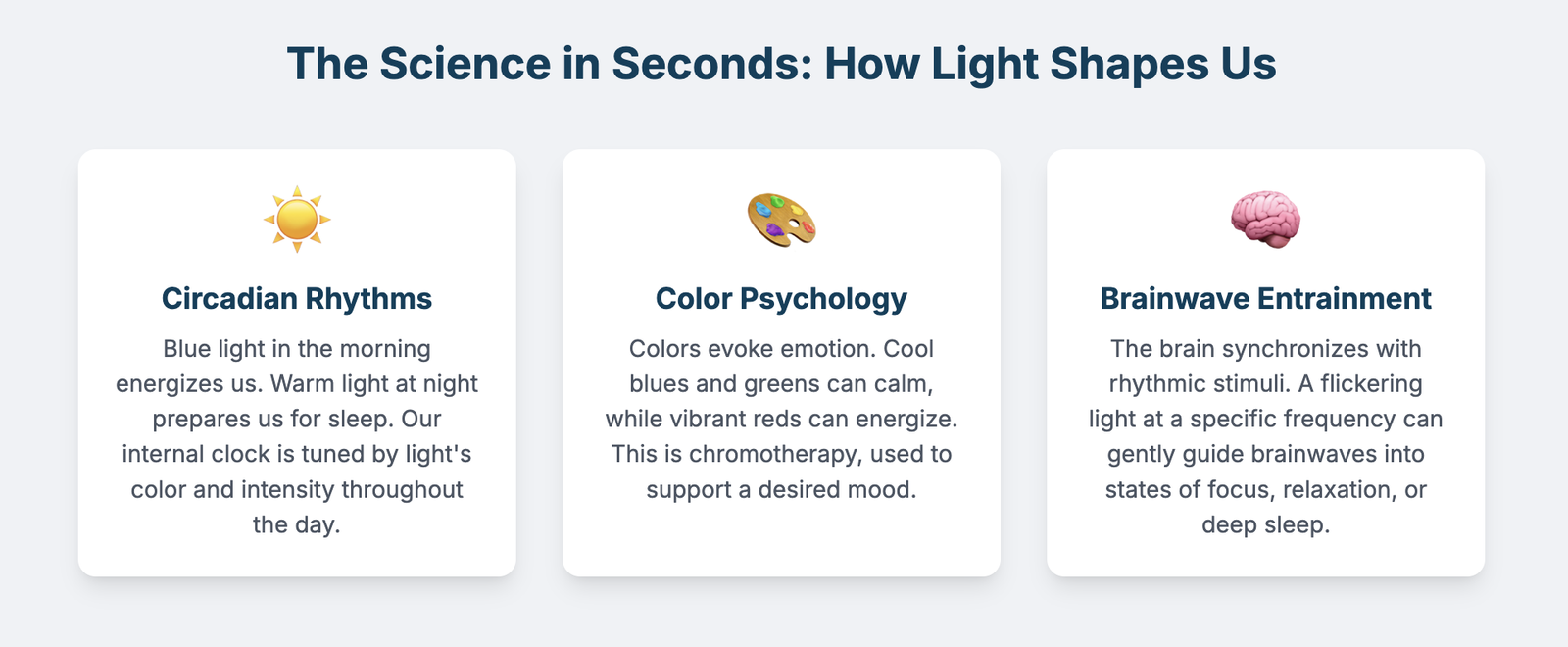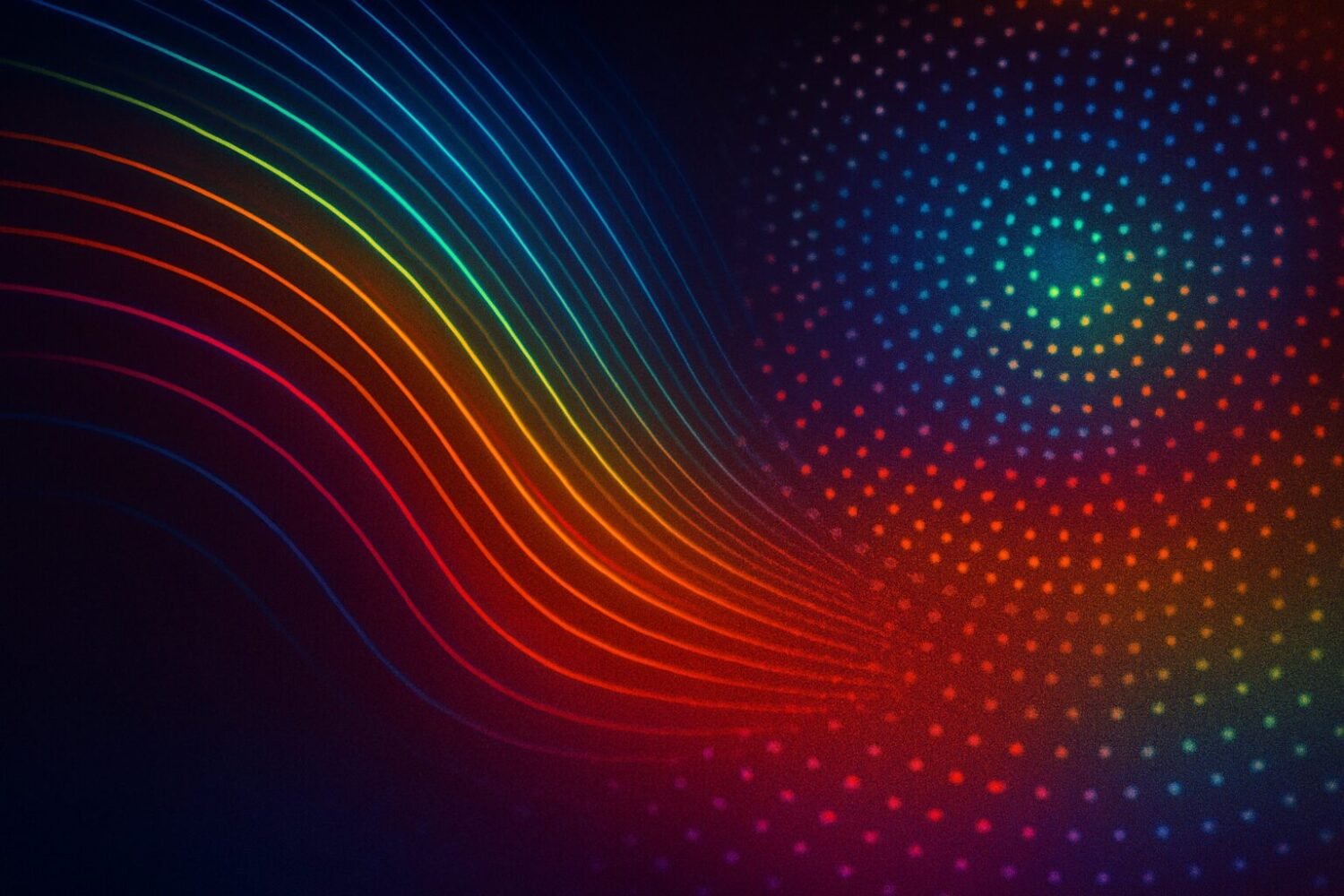
A Framework for Modulating Psycho-physiological States with AI-Generated Light, Color, and Rhythmic Flicker
Why Visual Patterns Can Be Biohacked in 2025: Scientists now recognize that light is more than vision it’s a tool to shape brainwaves, circadian rhythms, and mood. Flickering and color on a screen or LED lamp can entrain brain activity (e.g. 10 Hz flicker boosting α‑waves for calm, 40 Hz for high‑cognitive γ‑activity) and influence sleep, focus, or energy levels opening doors for “visual medicine” and personal biohacking.
🧠 How It Works: Light, Color & Flicker to Shape Mind‑States
-
Brainwave entrainment: Flickering light at rates matching Δ (0.5–4 Hz), θ (4–8 Hz), α (8–12 Hz), β (12–30 Hz), or γ (30–70 Hz) encourages cortical synchrony and corresponding mental states.
-
Color & Temperature: Warm hues (red/orange/amber, ~1000–2000 K) support rest and parasympathetic balance. Cool, high‑Kelvin tones (blue/white, ~6500 K) enhance alertness via melanopsin-sensitive pathways.
-
Motion & Scenes: Slow, rocking scenes support relaxation; rapid imagery supports flow and engagement. Combining flicker and scene motion amplifies effect.
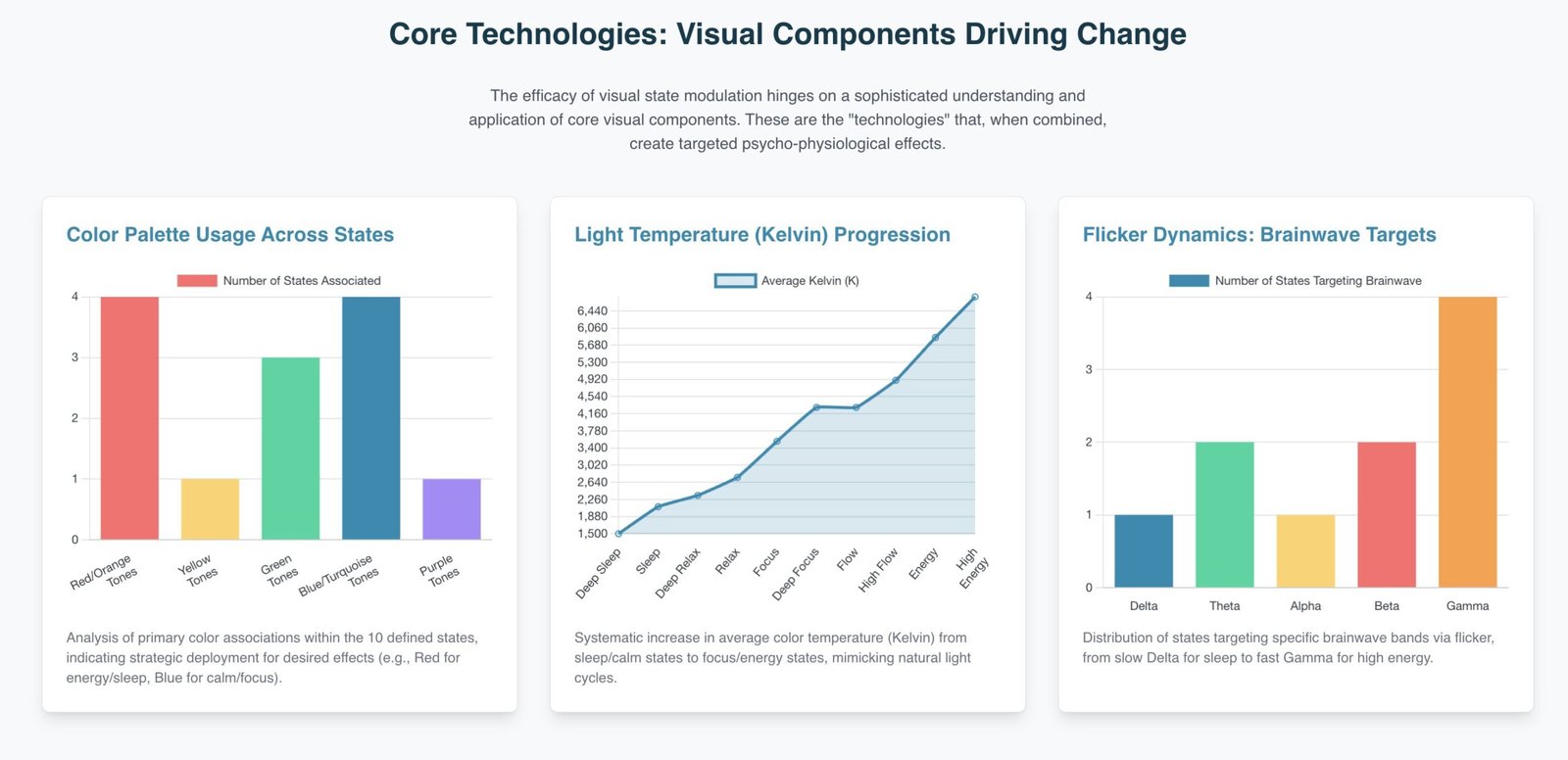
Beyond flicker and color temperature, the visual language of palettes, motion, and geometric shapes plays a profound role in modulating psycho-physiological states. Soft, desaturated palettes like earth tones or pastels tend to evoke calm and grounding, while high-saturation contrasts (e.g., neon on black) can stimulate arousal or alertness. Motion speed and direction also impact perception: slow, fluid movements mimic nature and promote parasympathetic activity, whereas rapid or erratic motion can trigger heightened focus or, if overwhelming, stress. Shapes matter too rounded, organic forms are typically soothing, while sharp, angular patterns activate attention and cognitive engagement. AI-generated visuals that dynamically adapt these parameters like morphing from mandala spirals to flowing landscapes can guide users into meditative, focused, or energized states with surprising precision, forming the foundation of a visual language for mental state design.
(This design logic builds on Life Stream Visuals’ dataset, which associates palettes, motion, shapes, and flicker terms with states like Deep Sleep or High Energy.)
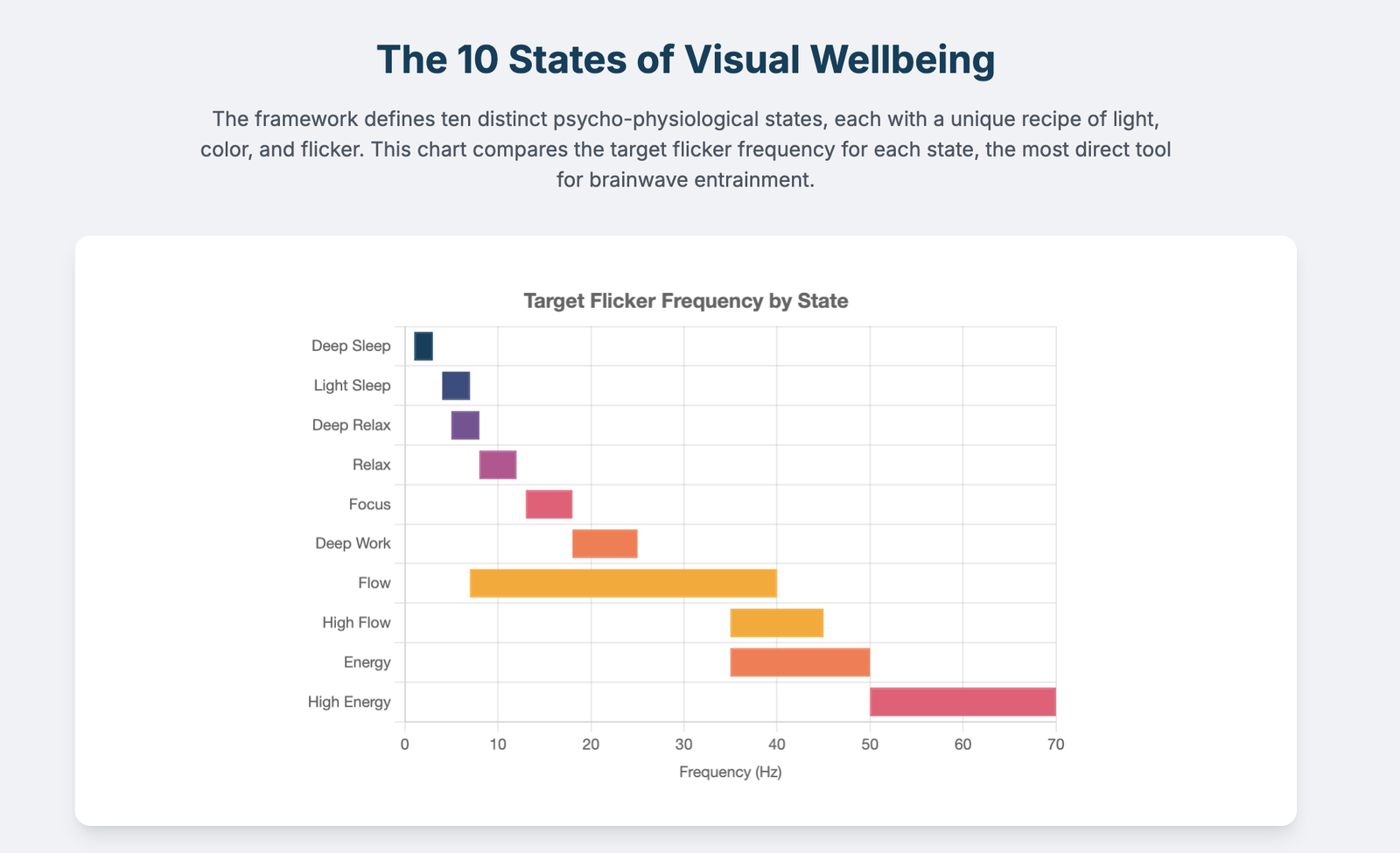
🔴 What About Infrared? The Invisible Light Healing You
While most visual biofeedback relies on light we can see, Infrared Light Therapy (IRLT) taps into invisible wavelengths (700–1000+ nm) to stimulate deep cellular repair. Near-infrared (NIR) and red light (620–750 nm) are widely used in longevity and performance protocols due to their ability to penetrate tissue, enhance mitochondrial ATP production, and reduce inflammation. Clinically, IRLT has been shown to improve wound healing, cognitive function (via transcranial photobiomodulation), and muscle recovery. Unlike visible flicker used to entrain brainwaves, infrared operates biochemically yet it complements visual wellbeing systems. Imagine a future where your screen visuals guide your nervous system, while ambient NIR panels quietly recharge your cells both orchestrated by AI adapting to your state in real time. This convergence marks the next frontier of full-spectrum light therapy.
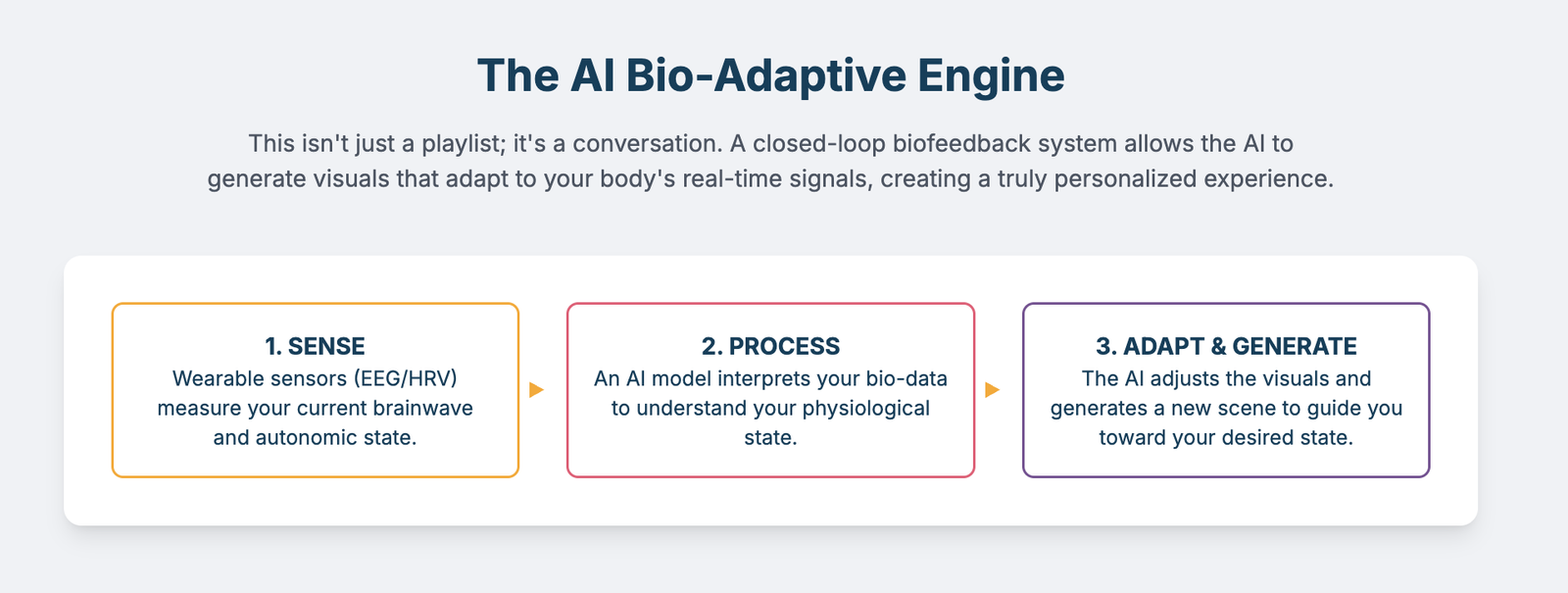
AI in 2025: Generative Video Meets Real‑Time Biofeedback
2025 is the year of advanced video AI: tools like OpenAI’s Sora, Google’s VEO3, and Kling generate dynamic visual scenes via text prompts matching desired color, flicker, and motion. When combined with wearables (EEG, HRV), AI can adapt visuals in real time slightly modulating flicker frequency or shifting color palette based on measured alpha or stress levels.
Example use‑case: A system tracks rising stress (via dropping alpha waves) during a work session → seamlessly transitions a blue-green 10 Hz flicker “forest” to restore calm. Or, just before an exam, flicker pulses increase toward 15 Hz with warm yellow tones to support focus.
Ethics, Personalization & Design Guidelines
-
Safety first: Flicker in 5–30 Hz overlaps seizure risk zones. Users must be able to disable flicker; warnings and low‑intensity defaults are essential.
-
User agency: Visual changes must align with user goals—not be subliminal or manipulative. Transparency about how and why visuals adapt builds trust.
-
Privacy: Physiological data (EEG, HRV) is sensitive. Processing should happen on-device or locally; sharing only with user consent.
-
Inclusivity: Allow preference customization—from scene style to color palette, to suit user tastes, mood, and cultural context.
What’s Next? Research & Clinical Applications
This field is primed for rigorous trials. Proposed experiments include:
-
Testing whether an AI-generated 10 Hz blue forest increases alpha power and reduces cortisol more effectively than static blue light or ambient scenes, providing measurable stress reduction via visual entrainment.
-
Comparing repeated use of γ‑flicker visuals (e.g. 35 Hz white strobe) for cognitive performance, assessing both short-term gains in attention and long-term effects like habituation or neural fatigue.
-
Studying how aesthetic preference (e.g. ocean vs forest scenes) affects the efficacy of entrainment, to determine whether beauty and emotional resonance enhance or hinder physiological modulation.
-
Exploring the induction of altered or “cyberdelic” states through high-frequency, color-rich, rhythmic light patterns, mimicking the neural signatures of psychedelics (e.g., increased gamma coherence, ego dissolution) without substances. These digitally induced trance-like or meditative states could be used for guided therapy, trauma processing, or creative ideation.
Clinically, targeted visual environments could support insomnia treatment, ADHD focus regulation, stress resilience, or mood support without drugs.
Visual stimuli – when carefully engineered are powerful tools to modulate sleep, focus, relaxation, and performance. With AI‑generated video and biofeedback, we now have the ability to deliver hyper‑personalized visual interventions on demand. This approach bridges neuroscience, design, and wellness and heralds a new form of visual therapy for mental and physical wellbeing.
Join the Movement: Shape the Future of Longevity
This is more than just a new diet trend; it’s a paradigm shift in how we approach health and wellness. We are at the forefront of this exciting field, and we believe that collaboration is key to unlocking its full potential.
We invite you to join our working group of pioneers, researchers, and health enthusiasts. Share your insights, contribute to the conversation, and be among the first to experience the transformative power of personalized nutrition.
Ready to embark on your personalized health journey?
- Download our in-depth report to explore the science behind hyper-personalized visual stimuli.
- Listen to our audio overview for a convenient and engaging summary.
- Join State On Demand community and become a part of the AI multisensory revolution.
“The future of mental health is visual. The future of healing is frequency. Let’s tune it together.”
— Prem Sangeet (Petar Savic)
🔬 Explore downloadable open‑source stimuli, parameter tables, and prototype visuals in our main research repository.
AI Visual Wellbeing Research Paper_


